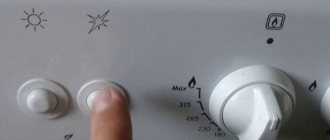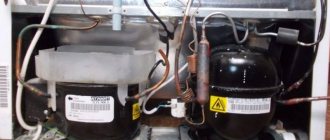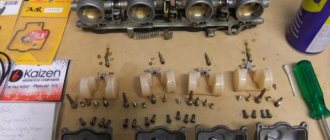Modern automatic washing machines belong to the class of household appliances with a high level of energy consumption. The maximum power consumption occurs during water heating and ranges from 2 to 3.5 kilowatts. Electrical wiring in many residential areas, especially early buildings, were not designed for such an amount of energy consumption. And today there is a washing machine in almost every apartment. Electrical overloads, power surges and other network faults can lead to a fire or breakdown of an expensive washing machine part. To protect household appliances, it is necessary to be responsible for the correct installation and connection of the device. It is cheaper to install a special circuit breaker in advance than to repair or buy a new washing machine.
Parameters and characteristics of difavtomats
To decide which RCD to install for a washing machine or water heater, first familiarize yourself with the basic parameters and characteristics of the device:
Depending on the network in which the difavtomat will be installed (single-phase or three-phase), a two-pole device (for an operating voltage of 220 V) or a four-pole device (380 V) is selected.
Please note that the rated operating voltage must be indicated on the device body
- Rated current. This is the amount of current, measured in amperes, that can pass through a switching device over a long period of time. The standard range of rated currents is as follows: 6, 10, 16, 20, 32, 40, 50, 63 A.
- Time-current characteristic (“B”, “C” or “D”), this parameter expresses the dependence of the response time of the machine on the current flowing through it.
- Rated differential current. This is the amount of current leakage to which the difavtomat will react and turn off. There is also a standard range of differential current - 10, 30, 100, 300, 500 mA.
- Rated breaking capacity. This parameter represents the maximum value of short circuit current that the differential circuit breaker is capable of switching off and remaining in working condition after that.
- Temperature Range. It usually varies from – 20 degrees to + 45.
All these parameters are indicated on the device body.
There you will find a connection diagram, the nominal frequency of the power supply (50 Hz), the type of built-in RCD (electronic or electromechanical).
Also, differential circuit breakers are of three types depending on the form of current leakage to which they react:
- “A” – for alternating sinusoidal and constant pulsating current forms.
- “AC” – for alternating sinusoidal current leakage.
- “B” – for alternating sinusoidal, constant pulsating and rectified forms of current leakage.
Grounding the washing machine
Let's start with installing the ground loop. To do this, on the street near the wall of the house or in the basement, 3 pieces of galvanized pipe at least 50 cm long are driven into the ground. Steel strips or corners 50 cm long or more are welded to them. It is advisable to place the pipes at the vertices of the triangle, but it is also permissible to place them on the same straight line if space does not allow. A wire is screwed to the pipe with a bolt, which is pulled into the apartment and inserted into the panel. To connect the washing machine to the network, install a European standard socket, which is connected to a separate automatic switch in the panel. It is selected based on the estimated current consumed by the washing machine. Below is an example of a calculation that allows you to estimate the magnitude of this current. It is determined from the rated electrical power of the consumer, the value of which is indicated in the operating instructions in the technical characteristics section. The power taken in watts must be divided by the mains voltage (220 V). 20% is added to the resulting value and the average current is obtained. After this, you can select a protective device with a shutdown current equal to or slightly greater than the calculated one.
Electricity consumption calculation
An example of such a calculation: the nominal power consumption of a washing machine is 2200 W. The current in the nominal mode will be 10 A. The 20% margin is 2 A. We find that the shutdown current must be at least 12 A. It is recommended to choose a differential machine for a washing machine with the closest shutdown current value of 15 A and a differential shutdown current of no more than 30 mA.
Note that the value of the shutdown current should be taken as close as possible to the calculated one. For example, you cannot install a circuit breaker with a shutdown current of 45 A, if the calculation shows 12. This is dangerous primarily because in the event of emergency currents flowing, reaching 20-30 A, such a machine will not work and will not turn off the damaged equipment in a timely manner.
Power calculation for RCD
Each individual device has its own threshold current load, at which it will operate normally and will not burn out. Naturally, it should be higher than the total current load of all devices connected to the RCD. There are three types of RCD connection diagrams, each of which has its own calculation of the device’s power:
- A simple single-level circuit with one protection device.
- Single-level circuit with several protection devices.
- Two-level shutdown protection circuit.
Calculating power for a simple single-level circuit
A simple single-level circuit is characterized by the presence of one RCD, which is installed after the meter. Its rated current load must be higher than the total current load of all consumers connected to it. Suppose the apartment has a boiler with a capacity of 1.6 kW, a washing machine with a capacity of 2.3 kW, several light bulbs with a total capacity of 0.5 kW and other electrical appliances with a capacity of 2.5 kW. Then the current load calculation will be as follows:
(1600+2300+500+2500)/220 = 31.3 A
This means that for this apartment you will need a device with a current load of at least 31.3 A. The closest RCD in terms of power is 32 A. It will be enough even if all household appliances are turned on at the same time.
One such suitable device is the ERA NO-902-126 VD63 RCD, designed for a rated current of 32 A and a leakage current of 30 mA.
We calculate the power for a single-level circuit with several protection devices
Such a branched single-level circuit assumes the presence of an additional bus in the meter device, from which wires depart, forming separate groups for individual RCDs. Thanks to this, you can install several devices on different groups of consumers or on different phases (with a three-phase network connection). Typically, a separate RCD is installed on the washing machine, and the remaining devices are installed for consumers, which are formed into groups. Suppose you decide to install an RCD for a washing machine with a power of 2.3 kW, a separate device for a boiler with a power of 1.6 kW, and an additional RCD for the rest of the equipment with a total power of 3 kW. Then the calculations will be as follows:
- For a washing machine - 2300/220 = 10.5 A
- For a boiler - 1600/220 = 7.3 A
- For other equipment - 3000/220 = 13.6 A
Taking into account the calculations, for this branched single-level circuit, three devices with a power of 8, 13 and 16 A will be required. For the most part, such connection schemes are applicable for apartments, garages, temporary buildings, etc.
By the way, if you don’t want to bother too much with installing such a circuit, then pay attention to portable RCD adapters that can quickly switch between sockets. They are designed for one electrical appliance
Calculating power for a two-level circuit
The principle of calculating the power of a residual current device in a two-level circuit is the same as in a single-level circuit, with the only difference being the presence of an additional RCD located at the entrance to the apartment, before the meter. Its rated current load must correspond to the total current load of all devices in the apartment, including the meter. Let us note the most common RCD indicators for current load: 4 A, 5 A, 6 A, 8 A, 10 A, 13 A, 16 A, 20 A, 25 A, 32 A, 40 A, 50 A, etc.
An RCD at the input will protect the apartment from fire, and devices installed on separate groups of consumers will protect a person from electric shock. This scheme is the most convenient in terms of repairing electrical wiring, as it allows you to disconnect a separate section without disconnecting the entire house. Also, if cable systems need to be repaired at an enterprise, you won’t have to shut down all office premises, which means there won’t be massive downtime. The only disadvantage is the considerable cost of installing an RCD (depending on the number of devices).
If you need to choose an RCD for a group of circuit breakers for a single-phase network, we can recommend the ERA NO-902-129 VD63 model with a rated current load of 63 A - this is enough for all electrical appliances in the house.
Installation required
The machine will provide reliable protection for electrical wiring and the device itself. The washing machine is considered one of the largest consumers of energy and creates a significant load on the wires. In addition, the device operates in a “wet” environment, which puts it in a high-risk group and requires good protection.
Based on this, experienced specialists recommend installing an RCD for a washing machine in order to maintain the functionality of the device, protect residents from electric shock, and protect property from fire.
Why does the RCD trip when the washing machine is turned on?
There are situations when when you turn on the washing machine, the protection is triggered, which leads to the shutdown of all electrical appliances in the house. There may be several reasons for this: (See also: What to do if the machine knocks out when you turn on the washing machine)
When turned on, there was indeed a voltage surge or current leakage in the wiring; Incorrect installation of the protective device; A circuit breaker that is not suitable for the electrical network parameters has been installed, therefore, when turned on, a false operation of the protection occurs; The power cord of the automatic washing machine is short-circuited; The control unit, heating element or washing machine motor has failed; Malfunction of the protective device itself.
A competent choice and correct installation of an RCD or automatic circuit breaker for a washing machine will help maintain the operation of the washing machine, protect it from voltage surges and current leakage, but also protect the house from fires, and family members from electric shock. It is better to take care of protection in advance than to eliminate the consequences of electrical faults later.
Rated current
By rated current we mean the maximum amount of current that the device can withstand for a long time without melting or damaging its contacts and other components.
Roughly speaking, it will work as if nothing had happened, retaining all its protective functions.
Do not be confused, if this value is exceeded, the RCD will not turn off! The circuit breaker should do this for him.
The main rule here is that the rated current of the RCD must be equal to or be one step higher than the current of the circuit breaker protecting this section of the circuit. That is, a machine that is located after the RCD.
Please note that many manufacturers simply do not have an ouzo for 32A. Basically, this denomination is found only among Chinese comrades
Therefore, the choice in the plate Inom = 40A is due precisely to this.
If your RCD is located at the input, then its current should be one step greater than or equal to the current of the input circuit breaker.
When several consumers with different circuit breakers are connected to one RCD in a group, then focus on the sum of their currents.
But what if this amount turns out to be even greater than the current of the input switch? Then take into account the introductory machine.
If you are completely confused in these calculations, you can use a convenient mnemonic diagram for selecting an RCD from KonstArtStudio.
Just answer a couple of questions in the navigation blocks and you will get the desired result.
Criterias of choice
Having given preference to a difavtomat, you need to carefully consider the process of selecting it. Initially, you need to familiarize yourself with the performance characteristics of the product.
Rated voltage and phase pattern.
Choosing the right differential machine in accordance with the required parameters is not difficult. Devices designed to operate in a single-phase network (220 V) are equipped with three connection terminals, while devices for three-phase networks (380 V) are equipped with four poles. The rated operating voltage is indicated in the passport and marked on the product body.
Current rating and characteristics
In order to ensure high-quality operation of the differential machine, it is important to choose the correct current rating and characteristics. Information about these parameters is indicated by a letter of the Latin alphabet and a number, for example, C25, which means a device with characteristics C, with a rated operating current of 25 A
The most popular differential automatic machines for apartments and private houses are products with characteristics C. When choosing a differential automatic machine based on power, it is recommended to adhere to the values indicated in the table:
Leakage current.
Indicated by the “delta” symbol with a number corresponding to the rated leakage current in milliamps. The data in the second table will help you choose the right circuit breaker based on leakage current:
Important! For a water heater, washing machine, bathroom or bathhouse, you need to choose a device that operates at 10 mA. For a group line, it is enough to select a 30 mA characteristic if you decide to divide the wiring into groups
For input into a private house, to protect against fire, it is recommended to install a 300 mA difavtomat, and in apartments it is enough to use a device rated at 100 mA.
RCD class
. The RCDs built into the differential circuit breaker are divided into two classes:
- A - triggered as a result of DC leakage. To connect consumer electronics consumers to the network, you should select an RCD of this class
- AC - turn off the automatic circuit breaker when AC leaks appear in the network and on electrical equipment.
Protection against neutral conductor breakage.
Some difavtomats are equipped with units that disconnect consumers in the event of a break in the neutral wire.
When arranging equipment protection against current leakage, it is advisable to choose just such a product. Another important characteristic is the shutdown time
(denoted as Tn). It should not be more than 0.3 s.
For a person who is unsure that he will be able to choose a difavtomat himself, it is recommended to make a purchase from trading companies with a high reputation, where he should seek help from a qualified consultant. You can discuss with him the issues of an acceptable price and which manufacturer of differential automatic machines should you choose.
Finally, we recommend watching a useful video on the topic:
So we looked at how to choose a difavtomat based on power and leakage current. We hope the information provided helped you understand the choice of a suitable differential machine for your home, cottage or apartment!
We also recommend reading:
- The best manufacturers of circuit breakers
- How to choose an RCD for an apartment
- Connecting the automatic machine yourself
Schemes for 3-phase network
In homes, industrial premises and other structures, there may be a different option for arranging power supply.
Thus, for apartments, connecting a 3-phase network is uncharacteristic, but for equipping a private house this option is not uncommon. Here other circuits for connecting the protection device will be used.
Option #1 – general RCD for a 3-phase network + group RCDs.
For a 380 V network, a 2-pole device is not enough; a 4-pole analogue is needed: you need to connect 1 neutral wire and 3 phase wires.
The circuit is complicated by equipping each power line with a separate RCD device. This is not necessary, but duplicate protection is recommended for additional protection against leakage currents
The type of wires is important. For a 1-phase network, a standard VVG cable is suitable, while for a 3-phase network it is recommended to install the more fire-resistant VVGng cable. We wrote about choosing the appropriate type of wire in our other article.
Option #2 – general RCD for 3-phase network + meter.
This solution completely repeats the previous one, but an electricity meter is added to the circuit. Group RCDs are also included in the system for servicing individual lines.
Of all the presented diagrams, this is the most voluminous in the literal sense, that is, it requires the installation of a large electrical panel with many wires and connected electrical appliances
There is a nuance that applies to any of the presented schemes. If an apartment or house has several lighting and socket circuits, several powerful household appliances that require the installation of separate power lines, then it makes sense to install double protection with a common RCD.
Otherwise, either a common device or one for each circuit is sufficient.
We select an RCD according to 2 main parameters
A residual current device is a device that protects people and property from two dangers - fire and electric shock.
There are two types of residual current devices - differential circuit breaker or differential relay. Both of these devices are very similar and interchangeable. In the future, we will consider a differential relay (together with a machine) as a protective device as the most economical and flexible option.
By what parameters do you choose the right RCD? Differential protection devices differ in operating current and leakage current (or differential current).
For complete leakage protection, a joint circuit breaker is required.
Connecting the washing machine to the mains
As a rule, the terms of the warranty for household appliances stipulate that it does not cover technical devices that have failed due to improper connection.
It is interesting that the stores themselves offer to use the connection service by calling their own “master”, who may turn out to be a driver, loader or forwarder who does not have the appropriate knowledge and permission to perform such work.
Therefore, before connecting an automatic washing machine to the electrical network, you should know how such a connection is made in order to control all stages of the necessary work. Better yet, find a specialist who will make the connection in compliance with all requirements.
General requirements for connecting a washing machine
The outlet into which the washing machine will be plugged must have a grounding contact. Washing machines usually have the power to be plugged into regular household electrical outlets with a grounding contact.
The installation location of the washing machine must be level and non-slippery. The best solution is to install it on a floor covered with ceramic tiles, with a rubber mat placed under the car, which acts as a shock absorber.
Safety requirements for electrical wiring and sockets
In accordance with the PUE, the bathroom is classified as a wet room, which has special requirements for electrical wiring.
This is largely due to the fact that in a damp room the likelihood of getting an electric shock increases, and in addition, people are often undressed in the bathroom, which also increases the risk.
The electrical wiring to the outlet into which the washing machine will be plugged in must be hidden. It is prohibited to lay wires with a metal sheath without insulation coating, as well as laying wiring in metal pipes or sleeves.
All electrical sockets installed in the bathroom must have a degree of protection of at least IP44 and have covers that cover the contacts when the socket is not in use. Electrical panels, junction boxes and switches are prohibited from being placed in the bathroom.
To protect against electric shock, grounding (grounding), potential equalization or protective shutdown must be provided. The most appropriate is a grounding and protective shutdown device.
In this case, under no circumstances should grounding be carried out using water pipes, since if high voltage comes into contact with the pipe, a fatal electric shock is possible. If the apartment electrical panel is grounded, then a grounding wire should be laid from it to the bathroom.
The cross-section of the grounding conductor must be greater than or equal to the largest cross-section of the wire used in the apartment.
The electrical connection diagram for the washing machine is shown in the figure below.
Residual current device
It is highly desirable to install a residual current device that de-energizes the circuit in a fraction of a second in the event of touching open current-carrying parts of the wiring.
The leakage current required for its operation should be lower than on a common apartment panel. This is done so that only the bathroom is de-energized.
When choosing an RCD, you need to consider whether the connected devices can produce direct leakage current or only alternating current. In the first case, type A RCDs are used, in the second - type AC.
Which cable should I use to connect the washing machine to the network?
The socket into which the automatic washing machine will be connected must be powered by a cable with a copper core in double non-flammable insulation. Copper wire is more durable than aluminum and has a smaller cross-section at the same currents. The wire should not be multi-core.***By following these simple rules, you will be able to connect your washing machine to the electrical network in compliance with all standards and requirements for safe operation.
Safety rules during work
Most of the rules are of a general nature, that is, they must be applied in the process of any electrical installation work.
If you decide to equip the electrical distribution panel yourself, before installing and connecting the RCD, do not forget:
- turn off the power supply - turn off the machine at the entrance;
- use wires with appropriate color markings;
- do not use metal pipes or fittings in the apartment for grounding;
- First of all, install an automatic input switch.
If possible, it is recommended to use separate devices for lighting lines, sockets, washing machine circuits, etc. Otherwise, installing a common RCD is sufficient.
To protect children, all electrical installations in a children's room are usually combined into one circuit and equipped with a separate device. Instead of an RCD, you can use a difavtomat
In addition to the characteristics of the devices themselves, the parameters of other electrical wiring elements are also important, for example, the cross-section of the electrical wire. It should be calculated taking into account the constant load.
It is better to connect the wires to each other using terminal blocks, and to connect to devices, use specially designed, marked terminals, as well as a diagram on the case.
What is it for?
The main requirement when installing an RCD on washing equipment
Before we talk about why an RCD is needed, let’s define those electrical circuit protection devices that every home needs to have. People uninitiated in the basics of electricians may confuse an RCD with a circuit breaker, which is also simply called a circuit breaker. This switch is an analogue of the well-known electrical plug with a fusible rate, which burned out if the current exceeded a certain value. However, unlike a stopper, this device is reusable and once it is triggered, when the toggle switch is turned on, it is ready for use again.
Typically, this circuit breaker cuts out the current supply during short circuits, which most often occur when the integrity of the insulation in the wiring is broken and the zero and phase are shorted. Thus, when the machine is triggered, the wiring or electrical content of household appliances is protected from damage and burnout, and the living space is protected from a possible fire. Household circuit breakers for residential premises with many electrical appliances must be rated for a current of at least 16 amperes. If the apartment has an electric stove, dishwasher and washing machine, electric water heater and other appliances with high energy consumption, then a circuit breaker of 25 amperes or more may be required.
Washing machine commissioning diagram
Let's consider a typical case with a washing machine when it is connected to a regular single-phase network without grounding. Let's imagine that for one of the reasons (due to old age, wear or mechanical stress) the insulation on some phase conductor was damaged, as a result of which the phase voltage reached the metal body of the washing machine. This will not affect the operation of the washing machine in any way and its behavior will not cause any suspicion. But, if a person accidentally touches simultaneously its metal body and any conductive object that has an outlet to grounding, for example, a water faucet or a heating radiator, an electric shock may occur.
At best, a person will experience unpleasant sensations, an electric shock. At worst, cardiac arrest is possible. The currents flowing through the body will be quite small and will not reach the value at which the circuit breaker is knocked out. After all, for a fatal shock to a person, a current value of 50 mA is sufficient, and circuit breakers are designed for a current of 16 amperes or more. To avoid such cases, it is necessary to install an RCD.
It is impossible to connect an RCD without a difavtomat
The RCD is connected in series with the consumer (microwave oven, washing machine, etc.) and measures the difference in current at the input and output. Ideally, this difference should be zero. In other words, as much current came in, so much came out. For this reason, these devices are also called differential automatic machines. The name comes from the English verb Difference, which means difference, difference. If a difference is detected, then there is a leakage current.
When the magnitude of the leakage current reaches the value for which the RCD is designed to operate, it knocks out the current supply in a fraction of a second, excluding fatal injury to a person. Currents greater than 50 mA are dangerous for humans, as discussed above. Therefore, to protect life, devices with a leakage current of no more than 30 mA are used.
Let's return to the above-mentioned case with a washing machine connected to a regular single-phase network without grounding. When a person touches the body of such a machine, which is energized as a result of an insulation breakdown, the device will disconnect it from the network when it detects a leakage current passing through the person’s body.
The situation will be completely different if there is a grounding circuit. If a voltage breakdown occurs on the body of the washing machine, the current will flow through the phase-ground circuit. Therefore, the RCD immediately knocks out the power circuit, thereby ensuring safety.
Protection options for single-phase network
Manufacturers of powerful household appliances mention the need to install a set of protective devices. Often, the accompanying documentation for a washing machine, electric stove, dishwasher or boiler indicates which devices need to be additionally installed into the network.
However, more and more often several devices are used - in separate circuits or groups. In this case, the device in conjunction with the machine(s) is mounted in the panel and connected to a specific line
Considering the number of different circuits serving sockets, switches, equipment that load the network to the maximum, we can say that there are an infinite number of RCD connection schemes. At home, you can even install a socket with a built-in RCD.
Next, we will consider the popular connection options, which are the main ones.
Option #1 – general RCD for a 1-phase network.
The location of the RCD is at the entrance of the power line to the apartment (house). It is installed between a common 2-pole circuit breaker and a set of circuit breakers for servicing various power lines - lighting and socket circuits, separate branches for household appliances, etc.
If a leakage current occurs on any of the outgoing electrical circuits, the protective device will immediately turn off all lines. This is, of course, its disadvantage, since it will not be possible to determine exactly where the malfunction is
Suppose that a current leak occurs due to contact of a phase wire with a metal device connected to the network. The RCD trips, the voltage in the system disappears, and it will be quite difficult to find the reason for the shutdown.
The positive side concerns savings: one device costs less, and it takes up less space in the electrical panel.
Option #2 – general RCD for 1-phase network + meter.
A distinctive feature of the scheme is the presence of an electricity meter, the installation of which is mandatory.
Current leakage protection is also connected to the machines, but a meter is connected to it on the incoming line.
If it is necessary to cut off the power supply to an apartment or house, turn off the common circuit breaker, not the RCD, although they are installed nearby and serve the same network
The advantages of this arrangement are the same as the previous solution - saving space on the electrical panel and saving money. The disadvantage is the difficulty of detecting the location of a current leak.
Option #3 – general RCD for a 1-phase network + group RCDs.
The scheme is one of the more complicated variations of the previous version.
Thanks to the installation of additional devices on each operating circuit, protection against leakage currents becomes double. From a security point of view, this is an excellent option.
Suppose an emergency current leak occurred, and the connected RCD of the lighting circuit did not work for some reason. Then the general device reacts and turns off all lines
To prevent both devices (private and common) from triggering at once, it is necessary to observe selectivity, that is, when installing, take into account both the response time and the current characteristics of the devices.
The positive side of the scheme is that in an emergency one circuit will turn off. It is extremely rare for cases where the entire network goes down.
This can happen if the RCD installed on a specific line:
- defective;
- out of order;
- does not match the load.
To prevent such situations from arising, we recommend that you familiarize yourself with the methods of testing RCDs for functionality.
Disadvantages - the electrical panel is overloaded with many similar devices and additional expenses.
Option #4 – 1-phase network + group RCDs.
Practice has shown that the circuit without installing a common RCD also works well.
Of course, there is no insurance against failure of one protection, but this can be easily fixed by purchasing a more expensive device from a manufacturer you can trust.
The circuit resembles the option with general protection, but without installing an RCD on each individual group. It has an important positive point - it is easier to determine the source of the leak.
From the point of view of economy, wiring several devices loses - one common one would cost much less.
If the electrical network in your apartment is not grounded, we recommend that you familiarize yourself with the diagrams for connecting an RCD without grounding.
RCD connection diagram
Power (electricity) can be supplied to both the lower and upper contacts of the RCD - this statement applies to all leading manufacturers of electromechanical RCDs.
Example from the instructions for the ABB F200 RCD
I divide RCD connection diagrams into 2 types:
- This is a standard connection diagram, one RCD, one circuit breaker. Do we remember that the RCD is selected with a rated current one step higher than the machine? If we have a 25A circuit breaker on the cable line, then the RCD should be selected for 40A. Below is an example of an RCD connection diagram for an electric stove (hob).
But, if we have an apartment or a private house, where there are 20-30 cable lines, then according to the first connection scheme our panel will be huge in size, and its cost will be the same as a budget foreign car)). Therefore, manufacturers allow the installation of one RCD per group of machines. Those. one RCD for several machines
But here it is important to observe the following rule: the sum of the rated currents of the machines should not exceed the rated current of the RCD. If we have an RCD for three circuit breakers, for example a 6 A circuit breaker (lighting) + 16 A (sockets in the room) + 16 A (air conditioning) = 38 A
In this case, we can choose a 40 A RCD. But you should not “hang” more than 5 machines on the RCD, because any line has natural current leaks (cable connections, resistance of machine contacts, sockets, etc.) in the end you will get a sum of leaks that exceeds the trip current of the RCD, and it will periodically trip for no apparent reason. Or if you install a machine with a lower rated current in front of the RCD, then you can “hook” the machines to the RCD without thinking about their rated currents, but, of course, we remember that more than 5 machines should not be connected to the RCD, because the amount of natural current leakage in cables and devices will be high and close to the RCD setting. Which will lead to false positives. From this diagram it can be seen that the sum of the rated currents of the outgoing circuit breakers is 16+16+16=48 A, and our RCD is 40A, but in front of the RCD we have a 25A circuit breaker, and in this case our RCD is protected from overcurrents. This diagram was borrowed from an article where I changed automatic machines and RCDs in an apartment panel.
Connection diagram for a three-phase electric motor via an RCD
Actually, there is nothing complicated about this; for the correct operation of a three-phase RCD, we connect the neutral conductor to the neutral terminal of the RCD on the power side, and on the motor side it remains empty.
The RCD should be checked at least once a month. This is done quite simply, just press the “TEST” button, which is on any RCD.
The RCD must turn off; this should be done when the load is removed, when TVs, computers, washing machines, etc. are turned off, so as not to “tug” sensitive equipment again.”
I like ABB RCDs, which, like the ABB S200 series switches, have an indication of the on (red) or off (green) position.
Just like ABB S200 switches, there are two contacts on each pole at the top and bottom.
Thank you for your attention
Safety switch installation diagrams
The RCD is not designed to monitor overloads in the electrical network, so it must be installed together with a standard “machine” - a circuit breaker. This way the protection will be complete in all problematic areas.
The standard diagram for connecting protective devices in an electrical panel is as follows:
- The first machine at the entrance is a machine.
- Then an electricity meter is installed.
- Then a fire protection RCD is connected (100–300 mA).
- Afterwards, the circuit is divided into several separate consumption lines with an RCD against electric shock (10–40 mA).
In some schemes, the first circuit breaker is replaced with a packet switch, and less powerful circuit breakers are then installed on consumer lines. This option also does not contradict the rules.
Image gallery
Photo from
General diagram for connecting a single-phase RCD
Differences between fire and conventional RCDs
Differential current switch and automatic circuit breaker
Installation of protective devices in different electrical networks
When connecting wires, it is important to ensure that the outputs from the RCD are not combined at a common zero and do not intersect anywhere with other neutral conductors or the panel body. After this protective device, the line should immediately go to another RCD or circuit breaker, and then directly to consumers
After installation is completed, it is necessary to check the correct assembly of the entire circuit and the functionality of the protective device.
First, some equipment is plugged into the outlet to create a load in the network and voltage is applied. If everything is correct and the insulation is intact everywhere, then no RCD trips should occur
Then the differential switch itself is checked. To do this, most RCDs have a “T” (“TEST”) button. When it is pressed, the calculated leakage current is simulated, as a result of which the protection should operate normally. Moreover, testing should work regardless of whether there is a load or not.
If when you press “TEST” the RCD does not disconnect the line, then it is faulty. It is possible that the leakage simulation circuit is broken. In this case, the protection device will continue to perform its functions as intended. However, even such a switch is better to be replaced immediately. It is recommended to carry out such a check once a month.
What types of RCDs and differential circuit breakers are there based on the type of current leakage?
Electrical circuits use different types of currents, which is why protective devices are usually divided into classes:
- AC type. This is a common class of devices that have a budget price, so they are often used in apartments and country houses. They are calculated for the leakage of alternating current, on which most household appliances operate.
- Type A. Allows you to detect both AC and DC leakage. In recent years, manufacturers have begun to produce devices adapted specifically for such RCDs. Switching power supplies are used here to regulate power. Since these are more reliable devices, they cost a little more than the previous ones.
- Type B. These RCDs also react to any current leakage. However, they are often used only at production facilities and in public places. It makes no sense to install them in an apartment.
The marking by which the class is determined is located on the body of the device
How does an RCD work and what is a difavtomat?
Before you start using expensive household appliances, you need to decide which method will be most effective to protect them.
A standard residual current device consists of:
- plastic case;
- current transformer;
- electromagnetic relay;
- current release;
- self-testing mechanism;
- New devices additionally have electromagnetic cut-offs.
Under normal network conditions, the relay does not operate, but if there is an increased load on the electrical wiring, the installed machine forcibly de-energizes the circuit, breaking it.
This situation can arise when there is a power surge in the network, a person touches a bare wire, and water gets on the wiring. If the circuit breaker trips, there is no need to replace it. Unlike fuses, this device is designed to be used over and over again.
Maximum protection for the washing machine will be provided by a modern device - a difavtomat, which combines a standard unit and an automatic machine. In addition to the fact that this device provides the full range of necessary protections, it also saves space in the distribution panel.
Features of the use of difavtomats
In order not to install separately the RCD and the automatic circuit breaker for a washing machine or boiler, you can replace these two switching devices with one device. This is a very popular differential circuit breaker that is widely used in household electrical networks.
The device is combined in one housing and combines the protective effect of both the RCD and the machine.
The difavtomat has one drawback: its high price. That is why many people prefer two switching devices placed in series (an RCD and a conventional circuit breaker).
But you just have to imagine how many automatic devices and RCDs will be needed for the bathroom, if some have a washing machine, a water heater, and an electric boiler there. And in private houses, the room is often adjacent to the bathhouse, where there is a stove. What type of distribution board should there be to accommodate such an amount of automation? It may happen that there is not enough space on the DIN rail for all the devices. Therefore, it is recommended to install a separate automatic switch on the washing machine, boiler and other household appliances in the bathroom.
Pros and cons of RCDs or difavtomats in the following video:
Availability of grounding
The presence of grounding for a washing machine is a mandatory requirement. This is indicated in the technical documentation and in any other connection instructions. Without grounding, the static voltage generated on the drum of an automatic machine can “break through” to the body, and even to water pipes and taps (especially if the entire water supply is on metal pipes).
Plugs for connecting washing machines most often look like this. The side contacts are just for connecting the ground to a compatible outlet
Also, static voltage can damage the vulnerable internal components of the washing machine. Most often, control boards “suffer” from it. And repairing such a breakdown can cost half the cost of a new device. And, by the way, connecting the washing machine to the electrical network without grounding is a violation of the warranty conditions. If it fails, even due to a manufacturing defect, the manufacturer has the right to refuse to carry out repairs.
What should be the grounding? The standard currently used is TN-S. In old apartment buildings in the Russian Federation, TN-C is often used. Is it possible to connect the machine to a network with such grounding? In theory, yes, but in practice, the protection will be inadequate. In this situation, the installation of a so-called PEN conductor (often called a “bus”) is required, with its division into channels N (zero) and PE (for grounding). Any electrician can handle this without any problems (it is prohibited to do this on your own, since it requires a partial change in the connection configuration in the switchboard).
As for the cross-sectional diameter of the grounding wire, in most cases 1 mm for copper and 2.5 mm for aluminum are sufficient. And if a regular three-wire wire is installed to connect the power supply to the washing machine, then the cross-section will be the same as that of the supply wiring.
Is it possible to ground the water pipe or radiators? In no case, as this will lead to the spread of static to the entire water supply or heating pipeline in an apartment building. And if the wiring is also installed with a residual current device (RCD), then the grounding connection in such a non-standard way will lead to its automatic operation when the washing machine is turned on.
What to do in private houses where there is no grounding at all? Output it separately for the washing machine (you can also connect a boiler, pumping station, dishwasher to it - these are the devices that consume the most electricity in the house).
Option for grounding in a private house
Electrical problems
It is very desirable for everyone to know the basic principles of connecting a boiler to a 220V network. Not only to ensure stable operation of the equipment, but also for your own safety.
Important: be sure to connect with grounding! Please note that the power cable plug is equipped with a special grounding connector, and accordingly it can only be plugged into an outlet with grounding contacts. A good connection option is a separate line directly from the panel. Plus install a separate RCD and a circuit breaker or difavtomat on this line, as protection against emergency conditions in the electrical network
Plus, install a separate RCD and a circuit breaker or automatic circuit breaker on this line, as protection against emergency conditions in the electrical network.
Brief background information about RCDs and automatic devices
An RCD (residual current device) is installed in the distribution panel and is designed to protect against leakage currents and fire. Plus, a circuit breaker (“circuit breaker”) is installed on it; it protects the line from short circuits and overloads. Or the second option is to install a difavtomat. This is a “2 in 1” device, both an RCD and a circuit breaker at once, in a single housing. What is most convenient is that you install protection against both possible leakage currents and short circuits. Decide for yourself what to do. But at a minimum it should be an RCD for the entire bathroom. Optimally - separately for the boiler. Because ideally, an automatic or differential is matched in terms of power to a separate device and, in fact, is connected to it.
How to choose a difavtomat for a boiler
For example, for a model with a capacity of 1.6 kW (most boilers sold in Ukraine are represented by models from 30 to 100 liters of capacity and from 1.2 to 2.5 kW of power). It’s easy to select a difavtomat for the boiler yourself, without the help of an electrician (but it’s better to have a master install it). First of all, determine the value of the rated current using the formula from the school physics course: I = U/R, which in the case of our boiler will be: 1600W/220V = 7.3A. Then it is convenient to select differentials with the same or the closest increasing rated current value in an online store catalog like this one. In our situation it is 10A.
Please note that there is also an indicator for the tripping characteristics of the automatic device: “B” (instantaneous operation, suitable for equipment without inrush currents) or “C” (with a slight delay in operation for equipment with inrush currents). For the boiler, select “B”
As for the nuances of choosing technical characteristics on the part of the RCD, models with a sensitivity value to leakage currents of 30 mA will be sufficient.
In total, a selection of differentials for a 1.6 kW boiler has been formed and can be ordered. Prices start from about five thousand hryvnia - for peace of mind and understanding that your boiler is fully protected electrically. Now, having discussed the connection, let's talk about possible problems with the electrical part.
Doesn't turn on? Start with the basics: check that there is power and that the socket and plug are working properly. The connection wire may be damaged. The easiest way to check is by ringing with an indicator screwdriver or tester. If everything is in order with the network, there is a possibility that the heating element has burned out (replacement is indicated), the thermostat has stopped working (replace) or the control board is broken (replace).
Does it give you an electric shock? Firstly, a pre-installed RCD will de-energize the line when dangerous leakage currents appear and will not shock you. Don't ignore this recommendation. Secondly, in 90% of cases this happens from mechanical damage or improper installation. It was dropped, bent, and the nut was not fully tightened during installation. In normal mode there should not be an electric shock. This may be a sign of cable damage. Or a breakdown of the heating element, when cracks or chips formed somewhere in the insulating layer, exposing the core, causing 220V to go directly into the water. More often typical for old boilers and in situations where the need to install a difavtomat was ignored. Replacement of the heating element is definitely indicated. It also doesn't hurt to check the grounding.
Knocks out the RCD (difavtomat)? The following factors are possible (in order of decreasing probability): the heating element has failed (replace); water leakage or condensation in the electrical unit or on contacts; problem with the RCD (least likely).
It constantly turns off or, on the contrary, often turns on - there is a problem with the thermostat.











